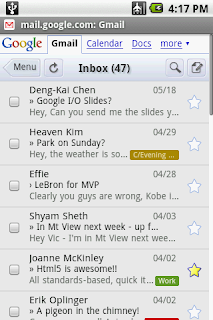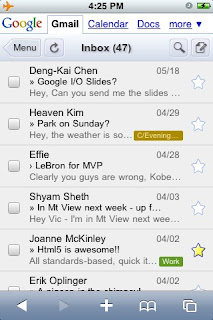Gmail for Mobile HTML5 Series: A Common API for Web Storage
On April 7th, Google launched a new version of Gmail for mobile for iPhone
and Android-powered devices. We shared the behind-the-scenes story through
this blog and decided to share more of our learnings in a brief
series of follow up blog posts. Over the last few weeks we've talked about how to use the
AppCache functionality of HTML5 to launch an application offline. We discussed the impact that
AppCache can have on your mobile web applications, as you enable users to launch your app
faster in the face of flaky or slow internet connections. This week, I'll talk about how we're
using both HTML5 Structured Storage and the Google Gears Database to make devices tolerate
flaky network connections.


Although these technologies allow web applications to cache user data on the mobile
device and perform data modifications locally, HTML5 Structured Storage uses an asynchronous
model, where the Google Gears Database uses a synchronous model. This difference makes it
difficult to develop an application on top of both platforms. We dealt with this problem by
creating the Web Storage Portability Layer (WSPL) for Gmail. Coming soon under a liberal open
source license to code.google.com/p/webstorageportabilitylayer, WSPL provides a common API
that supports an identical asynchronous programming model for both platforms by using a worker
thread in Gears. Let's take a look!
The WSPL consists of a collection
of classes that provide asynchronous transactional access to both Gears and HTML5 databases.
It can be used to execute nested statements within callbacks, create statement templates, and
optionally control the synchronous/asynchronous modes of the Gears Database Wrapper. There are
five basic classes.
google.wspl.Statement - A
parametrizable SQL statement class
google.wspl.Transaction
- Used to execute one or more Statements with ACID properties
google.wspl.ResultSet - Arrays of JavaScript hash objects, where
the hash key is the table column name
google.wspl.Database
- A connection to the backing database, also provides transaction support
google.wspl.DatabaseFactory - Creates the appropriate HTML5 or
Gears database implementation
Let's take a look at how we can use this
API to perform a simple query, starting with the creation of a Database. Note that you'll need
to provide a URL to the worker file hosted from your domain.
var database = google.wspl.DatabaseFactory.createDatabase('db name',
'http://yourdomain/dbworker.js');You can then execute SQL
statements without worrying about the specifics of HTML5 and Gears. Refer to the
recent blog posts about AppCache to find steps you can
follow to see your database contents using sqlite3.
var
statement = google.wspl.Statement('SELECT col from test_table;');
database.createTransaction(function(tx) {
tx.executeAll([statement],
{onSuccess: function(tx, resultSet) {
// Statement succeeded.
for(; resultSet.isValidRow(); resultSet.next()) {
window.console.info(resultSet.getRow()['col']);
}
}, onFailure:
function(error) {
// Statement failed.
}});
}, {onSuccess:
function() {
// After transaction commits, before any other starts.
},
onFailure: function(error) {
// After transaction fails, before any other
starts.
}});
I've found that using the Gears database
asynchronously will nicely split up the JavaScript execution, allowing event handlers and
other code to execute between the callbacks. This can improve the responsiveness of your
application if you're using long transactions. You can also use SQL triggers to avoid the
read-modify-write pattern that causes "ping ponging" between threads -- either the main thread
and Gears worker or the main thread and the HTML5 SQL thread.
That's
all I'll show you for now, but you can look for more details about the Web Storage Portability
Layer at Google I/O, May 27-28 in San Francisco where we'll be presenting a
session on the architecture of a generic application using HTML5.
We'll also be available at the
Developer
Sandbox and are looking forward to meeting you in person. Stay tuned for the next
post where we'll talk about improving the performance of HTML5-based web applications.
By Matthew
Bolohan, Software Engineer, Google Mobile

